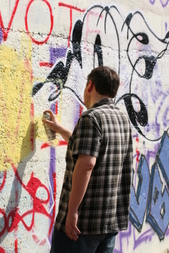Graffiti and Crime
Graffiti and crime go hand in hand. Below you will find quotes of police officials and renowned authors that have experience in these matters."Graffiti offenders in Saskatoon I've dealt with over the last nine years have been linked to arson, theft, assaults, break and enter, possession of child pornography, drugs and weapons, grow ops and murder. In the last three years I have seen more and more graffiti writers joining formal street gangs, increasing their involvement with other criminal offences. The bottom line is investing time and resources in investigating graffiti crime will pay dividends in the end because you decrease other, previously undetected criminal offences that the writers are committing."
- Lee Jones, Saskatoon Police Department (Canada) |
"From the earliest efforts to eliminate graffiti in the New York City subway, every department was involved and committed. Restoring order was not merely the responsibility of police, then, but an integrated effort involving a number of different agencies and social service providers, all of which engaged in a problem solving process to target a specific set of problems. The end result was not only order restored, but crime reduced and most probably, prevented. The fact is that in other settings, when they work in isolation from each other neither the police, citizens, nor today's criminal justice agencies have been able to reduces serious crime.
We believe that order-restoration and maintenance attempts are most effective and most likely to lead to crime prevention and reduction when a community mounts an integrated and comprehensive effort involving citizens, police, various criminal justice agencies, social service agencies, business, schools and city officials. When the effort is channeled through a problem-solving process toward a single target (such as graffiti) the splintered tendencies of the criminal justice "system" can be overcome. Where each agency strives not merely to do its job, but to coordinate its actions as part of achieving a common goal, the potential for success increases significantly. Police, prosecutors, correctional agents, and courts must learn to speak with one voice - and that voice should reflect neighborhood interests and controls."
- George L. Kelling and Catherine M. Coles, Authors "Fixing Broken Windows"
We believe that order-restoration and maintenance attempts are most effective and most likely to lead to crime prevention and reduction when a community mounts an integrated and comprehensive effort involving citizens, police, various criminal justice agencies, social service agencies, business, schools and city officials. When the effort is channeled through a problem-solving process toward a single target (such as graffiti) the splintered tendencies of the criminal justice "system" can be overcome. Where each agency strives not merely to do its job, but to coordinate its actions as part of achieving a common goal, the potential for success increases significantly. Police, prosecutors, correctional agents, and courts must learn to speak with one voice - and that voice should reflect neighborhood interests and controls."
- George L. Kelling and Catherine M. Coles, Authors "Fixing Broken Windows"
"Graffiti is not a petty crime. Most people do not realize how serious it is and the problems it brings to neighborhoods. My experience has shown me that there is a direct correlation between graffiti and serious crime. When we were able to significantly reduce graffiti in a community, we saw a considerable reduction in violent and gang crime as well."
- Commander Michael Rothans, Los Angeles County Sheriff's Department
- Commander Michael Rothans, Los Angeles County Sheriff's Department
"In the early 1990s, a major effort was made to clean up the subways in New York City…highlighted by a zero tolerance policy on graffiti. And while change is clearly evident in terms of quality of life and reduction in low-level crimes and incidents of disorder, a new development is the dramatic reduction as well in index crime, as reflected not only by what citizens experience but also in the crime statistics. Decline in the subway began almost immediately after the institution of an order-maintenance strategy…felonies have declined 75% and robberies 64%. In effect serious crime has ceased to be a major problem in New York subways.
At least two factors suggest the order-maintenance activities caused a reduction in crime. First, the onset of declines in crime occurred almost immediately after the order-maintenance activities were introduced. Second…no major anti-robbery or felony tactics were introduced. Are the changes in crime rates solely the result of police efforts? No, not likely. We believe that, most likely, they have come about as a result of the total commitment to order restoration, which included eliminating graffiti, target hardening, assertion of civilian control over territory as well as police efforts."
- George L Kelling and Catherine M. Coles, Authors "Fixing Broken Windows"
At least two factors suggest the order-maintenance activities caused a reduction in crime. First, the onset of declines in crime occurred almost immediately after the order-maintenance activities were introduced. Second…no major anti-robbery or felony tactics were introduced. Are the changes in crime rates solely the result of police efforts? No, not likely. We believe that, most likely, they have come about as a result of the total commitment to order restoration, which included eliminating graffiti, target hardening, assertion of civilian control over territory as well as police efforts."
- George L Kelling and Catherine M. Coles, Authors "Fixing Broken Windows"

